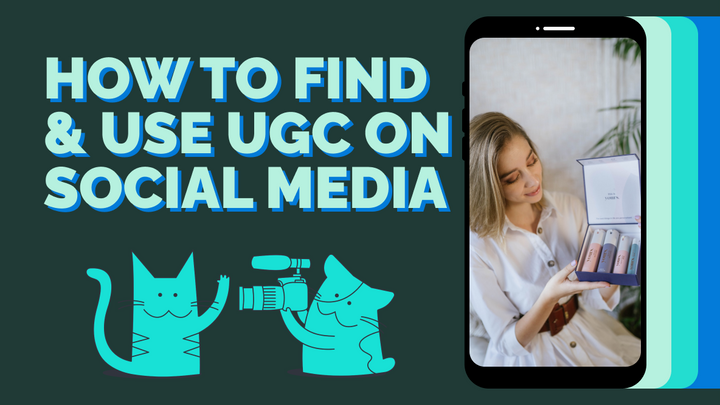3 Ways to Make Better Social Media Clips
Turning long-form videos into short clips is a great way to grow your reach if done right. Here are three ways to optimize video clips for social media.

AI-powered clip makers have the potential to be great time-saving tools for marketers looking to repurpose their long-form video content—if you can get the formula right.
If you’re struggling to make clips work on social media, you might be creating clips that are not edited to be engaging enough, lack substantive content that’s interesting enough, or, more broadly, don’t tie back into your larger content strategy.
Today, we’ll break down the basics about what clips tend to do well on social media and how you can use that knowledge in your own clip making.
Let’s look at three areas where you can optimize for better social media video clips.
Optimize for impact: Getting the clip content right
The success of your long-form → short-form strategy relies a whole lot on the actual long-form videos you make—that's your source material, and it plays a significant role in the quality of the clips you're able to create. There’s a lot that goes into creating a great long-form video strategy, especially for B2B. Before tackling the distribution issue, make sure you’re really nailing the message and execution of your long-form series or show.
If you’re getting the long-form content right, though, these are the main factors to consider when taking that content to social media as clips:
1. Promote your company’s POV
Not every piece of long-form content needs to be a thought leadership video essay, but if you want to use social media clips to grow your audience and reach, that content should have something important (and relevant) to say.
A video podcast is usually a good place to unpack key narratives and cover strong points of view in depth. Here’s an example from our own video podcast that we broke down into clips for social media.
@kapwing Repurposing video will continue to get more useful on a “do more with less” time in marketing #kapwing #marketing #social ♬ Roxanne - Instrumental - Califa Azul
A repurposed clip talking about repurposing, how meta. 🤓
As a bonus, you can also bring in outside perspectives with guests who add color and new viewpoints, all while expanding your reach when they share to their own channels. We’ll talk more about choosing guests as a lever for growing your reach in a moment.
2. Reinforce the value of your long-form format
Great clips share enough value that they can stand on their own but should compel viewers to seek out more of your content—on social and on long-form channels—by reflecting the best aspects of your long-form shows.
Most long-form videos make the viewers feel one (or more) of the following ways:
- “They get into the messy side of this topic I’m interested in with real, unfiltered stories.”
- “They always have super-smart guests who talk about ideas I’ve never heard before.”
- “The dynamic between the co-hosts is so fun to watch” OR “The format makes everything they talk about interesting.”
Identifying which core value your long-form show brings willl help you pick the right moments to turn into clips. For example, an “insight-dense” show wouldn’t focus (as much) on funny clips or personal stories where there’s no clear takeaway.
An AI-powered clipmaker can help you get to those clippable moments and nuggets of information faster, finding and editing them to be more succinct and impactful.
3. Pick the right platform
Even the best clips will flop if you share them to the wrong audience, so choose a platform that supports your goals and fits the content.
For example, it might be tough to make waves for your security compliance software on TikTok, but those same clips would likely do well on LinkedIn, as long as you also know your audience and optimize for engagement and reach.
Optimize for engagement: Editing the clips well
You don’t need to have a ton of editing experience to create great social clips. In fact, over-editing can actually get in your way. The Pareto Principle, or 80/20 rule, says that 20% of your effort results in 80% of the outcome. That’s certainly true for editing video.
There are three areas we recommend concentrating your focus when editing to create engaging clips.
1. Get your clips “social-ready” or don’t bother
Adapting your long-form content to a new platform isn’t just about trimming down and resizing the video. Clips need to fit into the landscape of native social content and first and foremost, that means adding captions.
The data is clear: Viewers on smartphones love subtitles. When adding subtitles to your video clips, they need to be:
- Accurate. Before anything else, subtitles are an accessibility feature. If they’re not accurate, your content’s not accessible. Period. Use a fast, accurate automatic subtitler that allows you to edit the transcript to account for any misspellings or grammatical errors, which will happen even with the best tools.
- Legible. Again, what’s the point of subtitles if you can’t read them? Make sure your subtitle font and color choices are easy to read. That means high contrast color choices and simple, straightforward lettering. Skip the handwriting script, even if it is more aesthetic. You’ll also want to use a safe zones filter to check that the subtitles won’t be hidden by the platform UI or covering up important elements in the video.
- Engaging. Adding some dynamic movement to your subtitles helps keep the viewers’ attention focused on what you’re saying. Try an animated subtitle, like the karaoke animation that follows along with the speaker. You can also add emojis to your subtitles for extra visual punch.
Another key factor when adapting long-form to short-form is context. Does this clip stand on its own? Or does it need some extra content to succeed?
Sometimes, clips contain really interesting ideas and stories but they unfurl in a sort of meandering way. This is particularly common when adapting a clip from a more conversational format, like a podcast. You can fix this with a small addition to the clip in the form of a short voice over or some talking head footage that gives viewers on social more context and a strong enough reason to keep watching before getting into the actual clipped footage.
Here’s an example from the Colin and Samir podcast:
At the beginning of this Short, they add about a three second voice over, laid over some B-Roll footage of their guest, MrBeast. The voice over provides quick context for the viewer and tees up the clip itself, which starts with a question. MrBeast himself is an incredibly popular YouTuber and has a huge amount of draw as a podcast guest, so the fact that Colin and Samir still added the extra context at the beginning of the clip shows how important it is to compel your audience to keep watching.
2. Stop the scroll with a 5-second hook
Viewers have notoriously short attention spans and this is especially true on social media. You have only a few seconds to grab and hold your viewers’ attention in a clip, so you need a strong hook.
Here are a few types of hooks that work well for social clips:
1. “Did you know…?” Start your clip by sharing a factoid or data point that’s surprising and not well-known.
2. Five-second storytime. Tell the arc of a story quickly, then let the clip unpack the details. This hook is great for case studies or sharing first-hand experiments.
3. Ask a polarizing question. Start with a unique question where the answer is polarizing or unclear, then answer the question in the clip.
In this example, Peep Laja asks “What worked to grow the business in the $0 - $1,000,000 phase?” then let his guest share their story.
Founders and CEOs tend to have strong opinions about the correct answer to this question, so it makes sense that this post did so well in terms of views and comments with this hook.
4. Start with a list. Lists work in every content format, and it’s no different for clips. Turn the discussion points into a clear list that you share up top, then go through and expand on each point during the clip.
5. Share a preview. Show a quick review of something that you’ll reveal in more detail later. Think of this almost like the “record scratch” meme, where you start in medias res then answer how you got yourself into that situation or arrived at that outcome.
Of course, there are plenty of other video hook formulas you can use, but these are the ones we recommend starting with, testing out, and learning what works for your content and audience.
3. Visual effects take time; choose wisely
Outside of subtitles, additional visual effects like custom overlays, keyframe animations, and from-scratch animations take a decent amount of time to edit. You should focus on nailing the content first before over-editing your clips—great content will perform well without premium editing. The editing is just an amplifier.
And you know what anything times 0 is, so let’s focus on getting the reach first.
In the beginning, lower-effort effects that make a video easier to grow work best. There's very little data on this, but experience and common sense says that quick text titles (especially in the intro), subtle transitions, and progress bars may help keep the furious social scroller around.
One study, for example, claims progress bars can drive a 3.7x increase in viewers finishing a video—but it hasn't been replicated.
Optimize for reach: Getting the distribution right
The last piece of the puzzle is making sure people actually see your clips. We could spend all day dissecting theories about the various social media algorithms, but playing whack-a-mole with the algorithm isn’t the best way to produce consistently performant content.
Instead, here are our three recommendations for how to choose clips for better reach.
1. Winning content usually wins again
Simply put: Videos that have taken off before did so for a reason. Browse through your existing videos and start making a list of the videos that have the most views and engagement. This can be a great starting point for generating your first clips.
You can also drill down further into your top videos to find specific moments that performed well.
Platforms like YouTube and Wistia have data that shows which sections viewers tend to rewatch—YouTube even makes this data public on many videos. These moments that cause people to stop in a long-form video are the first place you should look for short-form clips because you already know they have the power to grab people’s attention.
Here’s an example from Psych2Go’s popular video, “What Your Favorite Color Says About You.” You can see that the section on purple is the most replayed part of the video, which maybe tells you something about people who like the color purple. Clipping just this part of the video to share on social media would likely perform extremely well.
Bonus tip: Take note of what magic ingredients that moment has, so you can search and create similar moments in other videos. Did you share a particularly shocking fact or data point? Did you ask a thought-provoking question? Did you reveal an unexpected outcome from an experiment?
2. Get to the heart of a single idea
Social clips should leave viewers wanting to know more, but not because you left material out. Great clips share a single core idea or story that it’s easy to draw a clear line around. It feels complete in the clip even if it’s abridged. The reason to know more is because the clip whets your appetite, not leaves you hanging.
Chris Walker, founder of Passetto, does an excellent job of this in the B2B marketing world. Chris takes complicated topics and always gives a straightforward answer based on data and personal experience. His best performing clips all tend to lean on the “one big idea” principle, like this one:
The clearer and more widely understood the idea, the better the clip performs. Above all else, though, keep it all in one video.
Don’t be the “Like for part two!” guy. Please.
3. Interesting guests are the most consistent way to grow
Great guests bring reach, insight, or interesting stories—ideally, all three! But you only need them to bring one in full effect to see the benefit and most people make the mistake of over relying on reach.
The reach a guest brings does matter but it can be deceptive.
Poor-fit or boring guests with large followings on social media don’t always work out. Sometimes they’ve “done the circuit” on too many podcasts or shows with the same tired, recycled talking points. Their audiences, though large, may be tapped out from hearing their spiel on ten other shows already.
A guest with unique stories, though, or one who gels particularly well with your show’s host can do far better than an established “influencer” despite their smaller reach.
Let’s look at the New Heights podcast from the Kelce brothers as an example. Yes, it’s definitely outside of the world of B2B video but there’s something to learn from who they bring on the show as guests (and how those guests perform). The archive of New Heights episodes over the years features superstar players and coaches like Patrick Mahomes, Andy Reid, and Shannon Sharpe—yet many of their best-performing clips feature Jason Kelce's wife, Kylie, who only appeared on one episode.
That’s because at its core, the show isn’t a “football podcast.” It’s more about their lives and the relationship between the two brothers. And Kylie brought stories and rapport with Jason and Travis that other guests couldn’t.
As a brand, focusing on guests who have interesting insights and great camera presence is likely a better path to more views than just nabbing the biggest name on LinkedIn.
Making social clips that actually work for your brand
It turns out that creating great video clips for social media starts before you even make the long-form video you want to clip.
It’s not enough to just run any video through a clip maker and post the results. Like any video strategy, your repurposing workflow requires thoughtful optimization to see meaningful impact, engagement, and reach. Keep the content relevant, the message succinct, and the editing simple and you can start making social clips that both stand on their own as great content and drive eyes and ears back to your long-form efforts.
Create content faster with Kapwing's online video editor →








